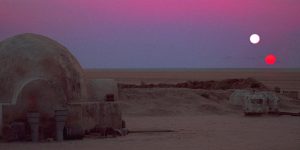
Thanks for the great question! Many people get confused about these two terms as you do. Hopefully I can help clarifying the difference.
The dictionary definition of “Twin” is a person or thing that is exactly like each other, or something containing or consisting of two matching or corresponding parts. Therefore, when an article says “Oh we have found twin suns!”, it means we found two star with matching physical properties, such as age, mass, brightness, chemical composition, etc. Twins don’t necessarily live close to each other, but just need to have matching DNA. The term “binary” means something having two parts and they do not need to be exactly the same. The “binary suns” term means two Sun-like stars (i.e., twin Suns) orbiting each other, in a binary system.
Unlike the stars in Star Wars’s Tatooine system, our Sun is not in a binary system. Sorry, our Sun is not as cool as Tatooine’s stars. But we are not completely isolated! Our nearest neighbor is called Alpha Centauri, which is actually a triple-star system (three stars gravitationally bound together). Two bright, closely orbiting stars are Alpha Centauri A and B, and their faint companion is Proxima Centauri. Alpha Centauri A and B appear to be a single star to the unaided eye and the third brightest in the night sky. This binary system lies 4.37 light years from the Sun. Proxima Centauri is actually our true nearest neighbor, “only” 4.24 light years away.

Many astronomers are looking for Sun-like stars to understand our own Solar System better. Such stars could also host habitable planets like Earth. UT astronomer Ivan Ramirez is one of those researchers. He and his team recently identified the first “solar sibling”, which is highly likely born from the same cloud of gas and dust where our Sun was born (read more about it
here: https://news.utexas.edu/2014/05/08/sun-sibling-astronomy).
Dr. Hwihyun Kim
UT, IGRINS Postdoctoral Fellow